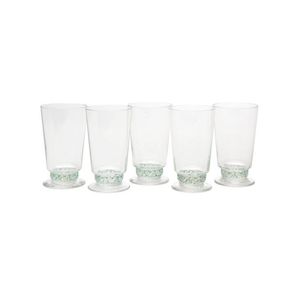Georgian Cordial Glass and Glassware Set
Georgian cordial glass, with internal spiral decoration and etched bird design to bowl, together with a glass handled mug and Regency glass tumbler with etched rose design and one cranberry red glass bowl (4), height 14 cm, 12 cm, 9 cm
You must be a subscriber, and be logged in to view price and dealer details.
Subscribe Now to view actual auction price for this item
When you subscribe, you have the option of setting the currency in which to display prices to $Au, $US, $NZ or Stg.
This item has been sold, and the description, image and price are for reference purposes only.
- Georgian - As an English stylistic period, Georgian is usually taken to cover the period from George I (1714) to the Regency of Prince George (1811-20), although the period from 1800 to 1830 is sometimes designated as the Regency period. During the Georgian period the great English cabinetmakers and designers such as Chippendale, Hepplewhite, Adam Sheraton etc., were all active.
Therefore there isn't a single 'Georgian style' as such and to say something is 'Georgian', usually means it was made between 1714 and 1830. This assumes we discount George V and George VI, both being from the 20th century.
The styles popular at the time of each reign were:
George I (1714-1727) saw out the last years of the Baroque period.
George II (1727-1760) reigned during the Rococo period.
George III (1760-1820) saw the last gasp of the Rococo, all of the early Neo-Classic 'Adam style' and most of the later neo-Classic 'Regency style'.
George IV (Prince Regent 1820-1830)encompassed the last of the 'Regency' style.
William IV's reign (1830-1837) was something of a no man's land (stylistically) and he wasn't a 'George' anyway. He covered the last glimmerings of 'Regency' and the start of the 'Victorian' style. - Etched - Glass decorated with an etched design, which is achieved through marking out the pattern, protecting the area that is not be etched, and then immersing the object in acid to dissolve the surface of the unprotected area. With some glass objects, such as cameo glass, there may be several layers of different coloured glass, and part of the top layer is dissolved leaving the bottom layer as the background. The longer the time of exposure of the object to acid, the deeper the etching.
The word etching is also sometimes used to describe another method of decoration, where wheel grinders were used decorate the surface, but this technique is usually known as engraving. - Tumbler - A drinking glass, without a handle, originally with a pointed or rounded bottom so that it could not be put down until empty. From the seventeenth century the glass tumbler had a heavy flat bottom, making it more likely it would not fall over. They were also made in silver, horn and ceramic. The concept of a drinking vessel which could not be placed on a table was not uncommon, as seen in a stirrup cup, the contents of which were drunk from the saddle. The same word is used to describe an acrobat who performs somersaults.
- Regency Period - The Regency period in English furniture design refers to the period when King George III, was declared unfit to rule in 1811, and his son ruled as proxy as Prince Regent, until 1820, and then, after the death of his father as George IV until his death in 1830. The Regency period was preceded by the Georgian period (George I, George II, and George III: 1714 - 1811), and was followed by the William IV period, which only lasted until 1837 when William IV died as was succeeded by Queen Victoria.
- Cranberry Glass - Cranberry glass is a type of glass that is characterized by its deep red color. It was first made in the 19th century and was particularly popular during the Victorian era. It was typically used to make decorative items such as vases and figurines. The red color was achieved by adding gold chloride or selenium to the glass mixture during the manufacturing process.
- Bowl - With drinking glasses, the bowl is the hollow section of the glass that holds the liquid. Many glasses were mounted on a stem joined to a foot, others were cylindrical, of tumbler shape. The size and shape of the bowl was determined by the type of liquids they were meant to hold. Shapes used included bell shaped, conical (funnel), bucket shaped, trumpet, cup, ogee, funnel, cylindrical and rounded.
This item has been included into following indexes:
Visually similar items

A French set of six Lalique wine glasses, 20th century, signed Lalique France to the base. 13 cm high
Sold by
in
for
You can display prices in $Au, $US, $NZ or Stg.

Lalique match holder / tealight, 7.5 cm high, in box
Sold by
in
for
You can display prices in $Au, $US, $NZ or Stg.

A set of six Lalique tumblers and water jug, signed to the bases. Height 18.5 cm max
Sold by
in
for
You can display prices in $Au, $US, $NZ or Stg.

R. Lalique A set of five Lalique Art Deco glasses, 'Dampierre', acid etched 'R. Lalique', 11.5 cm high
Sold by
in
for
You can display prices in $Au, $US, $NZ or Stg.
